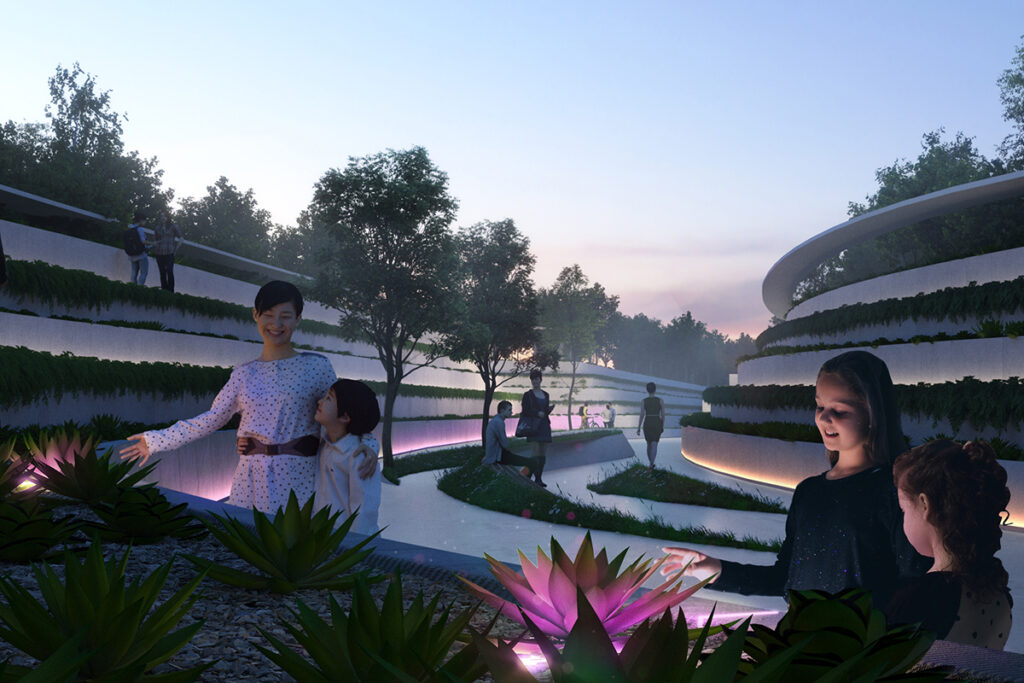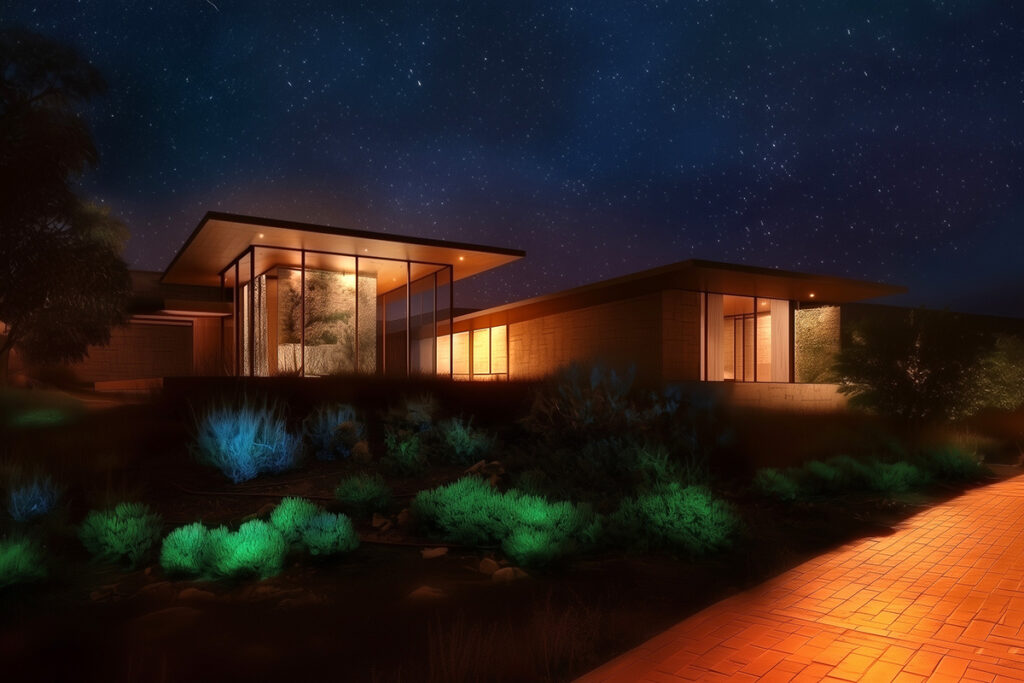It might sound fantastical, but Vidarte’s Barcelona-based company Bioo has deployed variations of the technology across three different approaches. The company already has installations in Riyadh using phosphorescent compounds, though specific locations were not disclosed, with brightness levels remaining limited to ambient lighting. Resort guests in Ibiza experience the world’s first biotechnological botanical garden with interactive plant installations. Meanwhile, natural bioluminescent fungi illuminate spaces without any modification whatsoever.
“In Dubai, we are making villas,” Vidarte told Arabian Business on the sidelines of GBB’s Real Estate Development Summit in Lisbon, Portugal. “Two, three months.”
Biotech cities of the future
The technology behind Bioo Lumina – the company’s bioluminescent landscaping system – represents what Vidarte calls “a leap forward in the lighting of urban green areas,” offering three distinct solutions that address different regulatory environments and brightness requirements.
Bioo’s approach splits into three categories: Natural solutions use over 58 species of bioluminescent fungi without modification, though light output remains dim. The Compound approach applies phosphorescent substances that plants absorb within 24 hours to eventually create consistent nighttime illumination while still maintaining normal biological functions.
“The compound itself doesn’t genetically modify the plant. It grows with it,” Vidarte explained. “The most important thing is that it doesn’t affect its offspring.”
A third Genetic approach remains in development, engineering plants to produce luciferase naturally, though this faces regulatory approval challenges across most markets.
Bioo’s technology has moved from laboratory experiments to real-world installations, though questions remain about long-term commercial viability. The company reports installations in Barcelona, Ibiza, and Riyadh, with varying scales and applications.
The largest project appears in Medina, Saudi Arabia, where a luxury resort features 120,000 square metres of luminescent plants arranged in star constellation patterns. The installation reportedly cost over €2 million ($2.35 million), though returns on investment remain undisclosed.
“It looks like a mirror, and it’s super cool. I mean, it’s like having a lake reflecting the stars, but without water. Just, luminescent plants.”
In Ibiza, the company operates what it describes as a biotechnological botanical garden featuring glowing plants and interactive installations where visitors trigger musical sequences by touching vegetation. The facility includes plant-activated systems that DJ David Guetta used for a 2018 performance.
Founded in 2015, Bioo has positioned itself as a leader in what Vidarte believes will be the next technological revolution. “The next revolution humanity will see is the biotech one,” he said, pushing back against the current AI obsession sweeping Silicon Valley and beyond.

The company’s broader mission extends far beyond glowing plants. Bioo has developed biological batteries capable of generating energy from soil decomposition, saving water, and absorbing CO₂. Their Bioo Panel technology can reduce irrigation needs by 50 per cent while regulating temperature by 4°C and absorbing 8kg of CO₂ per square metre.
“We’ve made sort of the mechanism that already is able to transform a park into an asset instead of a liability,” Vidarte explained. “What if we could now reshape the lighting of the park?”
The entrepreneur’s vision of “biotech cities” challenges conventional urban planning. These would be environments where buildings and infrastructure work symbiotically with nature, using biological processes to generate energy, purify air, and regulate temperature.
“We envision a greener future through a true symbiosis between nature and technology,” according to the company’s mission statement. Bioo estimates that interaction with plants can increase people’s well-being by more than 15 per cent, potentially extending life expectancy by 12 years.
For all its science fiction appeal, Bioo faces practical challenges in scaling bioluminescent landscaping. Current brightness levels suit ambient lighting rather than high-intensity illumination, limiting applications to parks, gardens and entertainment venues rather than major roads requiring safety lighting.
The phosphorescent compound approach requires annual maintenance as plants grow and dilute compound concentrations. Installation costs remain largely undisclosed, though industry estimates suggest approximately €19 (approx. $22) per square metre for large projects, potentially competitive with premium LED systems when factoring in zero electricity consumption.
Bioo claims its bioluminescent technology can reduce lighting-related energy consumption by up to 80 per cent, though independent verification of these figures is not available. The company suggests additional benefits including air purification and carbon sequestration, though environmental scientists question the introduction of phosphorescent compounds into urban ecosystems.
The breakthrough
Vidarte’s journey began in 2014 with a 3 AM breakthrough. “At 3 AM I woke up and I said, shit, that’s so cool that it needs to be done,” he said. Seven years of development followed before commercial launch in 2021, focusing on compounds ordinary vegetation could absorb naturally rather than genetic modification.
“I basically stayed in my own cave during several weeks [of] studying, learning. Then I created a team of volunteers – engineers and biotechs, from companies, universities,” he described of the early days.

At 34, Vidarte has accumulated over 20 international awards including recognition from Google and the European Parliament, among others. His vision extends beyond novelty lighting into “symbiotic architecture” where technology and nature actively support human well-being.
“If you woke up in a biotech city, the first thing you would do is touch a plant just to turn on the lights,” he explained. “Afterwards, you would go to your living room and you would see that there are plants hanging from the ceiling just compensating heat, working as a natural air conditioner. You would go out and you would see in your city that even the street lights are powered with the very same ground that the water that is generated, even in Dubai, for example, from the very same desert, from the soil itself.”
Plants, Vidarte said, have their own complex social structures. “They communicate through sound and through the roots, and they even have wars and allies and a lot of geopolitics. There’s a lot of geopolitics in plants.”
The company’s interactive installations tap into this plant communication, creating what Bioo calls “living libraries” where touching plants triggers recorded human messages. “It’s like an evolutionary monument that depends on the human being and nature, and only one of these two fails, everything goes away.”
Dubai’s embrace of bioluminescent landscaping aligns with the UAE’s Net Zero 2050 strategy and the emirate’s reputation for architectural innovation. The city’s growing luxury villa market increasingly competes on unique environmental credentials alongside traditional amenities.
Vidarte declined to name specific Dubai clients but confirmed residential and commercial installations are already underway. The technology offers villa owners something genuinely novel – gardens that glow without grid electricity. However, this raises questions about maintenance costs and practical utility beyond aesthetic appeal.
“We’re transforming the view of creating practical cities where you box yourself in concrete boxes, and where nature is just decoration outside. What if we could literally merge nature and technology?”
Bioo declined to provide specific project details or client names for competitive reasons.


